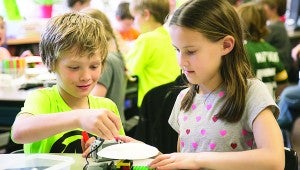Getting caught up in Charlotte’s Web
Published 9:59 am Thursday, March 26, 2015
Charlotte, Wilbur and a few other barnyard animals made a special appearance in Lego form for third-graders at West Side Elementary.
Students had fun learning with Legos on Wednesday afternoon during an activity session focusing on “Charlotte’s Web” – a story they had recently read in class.
Students in Courtney Mathena, Sara Penley and Kristen Grindstaff’s classes worked to make miniature models of farmyard animals from the story. Using the building blocks and a motorized Lego turntable, they decorated their own spiders to resemble Charlotte.
Gavin Heaton and Matthew Payne worked together in a group to build their farm animals.
“It’s fun playing with Legos to make our own characters,” Gavin said. “I made a duck and Wilbur.”
“We just finished reading the book,” Matthew said. “It makes the story better to do this.”
Caroline Price and Abby Crowder worked decorating spiders using the turntable and markers.
Caroline used a variety of spring colors to make her spider to match the season.
“I like Spring and it’s my favorite,” she said.
Abby made two spiders; one solid black and another with two brighter colors.
“I went a little crazy with it,” Abby said. “Charlotte’s Web was a sad story for me. Charlotte dies at the end and she just had babies.”
The session with the Legos was a substitution for a missed field trip – canceled because of snow – to see a performance of the story.
“This is a fun session geared toward the story of Charlotte’s Web,” Angi Grubb, co-owner of Bricks for Kids said. “They have been reading the story in class. This is just a fun project and they also learn.”
During a typical class session, the students would complete a STEM project and will then complete a model to go along with it.
“They see the engineering behind the movement, why it is happening,” Grubb said. “We learn, we build, we play with Lego Bricks.”
Students were divided into groups to work on the animal models or the spin-art spider. Corey Smith, also co-owner of Bricks for Kids, said the technic lessons were a little more difficult for the students because they were presented with new information.
“Learning the moving parts is a little more challenging,” Smith said. “The children are using Legos in a way they never have before. There are gears and axles. The students work their spatial reasoning and they learn to follow directions. There is also problem solving. If they miss a step or if something doesn’t work, they can go back and figure out what went wrong.”
Children are encouraged to continue working with Legos at home to build on their new skills.
“It is rewarding for us to see the light bulbs go off when they figure out something,” Smith said.




